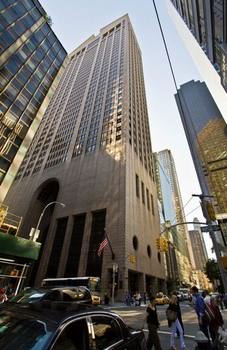Sony loses four years of love to cut off the United States headquarters for survival
 The Sony US headquarters building is located at 550 Madison Avenue, Manhattan, New York. It is a 37-story building with a seven-storey archway. It is a sign that New York City has experienced a decade of municipal chaos and the company has begun to recover after its flight.
The Sony US headquarters building is located at 550 Madison Avenue, Manhattan, New York. It is a 37-story building with a seven-storey archway. It is a sign that New York City has experienced a decade of municipal chaos and the company has begun to recover after its flight. Sony is cutting its non-core business to adjust its corporate strategy, including selling its US headquarters building.
On the 17th, US time, Sony announced that it had reached an agreement with the consortium headed by US real estate giant Chetrit Group. Its US headquarters building will be sold for US$1.1 billion. The deal will bring Sony’s operating revenue of US$685 million. The transaction is expected to Completed in March this year.
The price of US$1.1 billion also set a new high for single buildings in the United States in the past two years.
Stimulated by the good news, Sony's stock price rose by 12.21% on the 18th, the largest one-day gain since October 14, 2008.
This $270 million, 37-story building is located at 550 Madison Avenue, Manhattan, New York. It has a seven-storey arch and was opened in 1983. It was originally an AT&T headquarters building and it was a decade in New York City. The signs of municipal chaos and the start of recovery after the company fled the tide.
The New York Times stated that Sony purchased the building for $236 million in 2002. Sony said that after the sale, it will continue to rent the building for a maximum of three years, and the location of the new US headquarters has not yet been decided.
The New York Times stated that in December last year, 21 bidders submitted different plans, including retail, hotel and office use. In the days before the deal was reached, Sony also negotiated with four finalists. These finalists are willing to bid more than $1 billion.
After Kazuo Hirai took office as Sony's new CEO, he has been working hard to reverse the embarrassing situation of Sony's loss for four consecutive years. However, some analysts believe that the sale of the building is a plus for Sony Assets, but it cannot immediately change the investor’s investment ability. "If this sale is reasonable, Sony's cash is no longer sufficient. It is important that Sony can use this part of the revenue to develop a more attractive product," said Ms. Ruolinui, an analyst at Tokyo's Mito Securities.
Right now, Sony is cutting all types of non-core businesses and shifting its business focus to consumer electronics, especially smartphones, tablets, and games. Not only Sony, but also Japanese companies including Panasonic and Sharp suffered severe pain. The soaring yen, weakened export demand, fierce overseas competition and strategic mishaps have made it difficult for Japanese companies.
It is not just the sale of the US headquarters building. "Nihon Keizai Shimbun" said that Sony also decided to sell TV and other business units in the office building in Shinagawa-ku, Tokyo. The report also stated that it is expected that in the fiscal year 2012 ending March 31, 2013, Sony will achieve a net profit of 20 billion yen, while its net loss for the previous fiscal year is 456.7 billion yen.
WDM (Wavelength Division Multiplexing) combines two or more optical carrier signals of different wavelengths (carrying various information) at the transmitting end through a multiplexer (also known as a multiplexer), and The technology of transmitting in the same optical fiber coupled to the optical line; at the receiving end, the optical carrier of various wavelengths is separated by a demultiplexer (also called a demultiplexer or demultiplexer), and then the optical carrier is The receiver performs further processing to restore the original signal. This technology of simultaneously transmitting two or more optical signals of different wavelengths in the same optical fiber is called wavelength division multiplexing.
Wavelength division multiplexing is a technology that uses multiple lasers to simultaneously send multiple lasers of different wavelengths on a single fiber. Each signal is transmitted in its unique color band after being modulated by data (text, voice, video, etc.). WDM can greatly increase the capacity of the existing fiber optic infrastructure of telephone companies and other operators. Manufacturers have introduced WDM systems, also called DWDM (Dense Wavelength Division Multiplexing) systems. DWDM can support the simultaneous transmission of more than 150 light waves of different wavelengths, and each light wave can reach a data transmission rate of up to 10Gb/s. This system can provide a data transmission rate of more than 1Tb/s on an optical cable that is thinner than a hair.
Optical communication is a way in which light carries signals for transmission. In the field of optical communications, people are accustomed to naming them by wavelength instead of frequency. Therefore, the so-called Wavelength Division Multiplexing (WDM) is essentially frequency division multiplexing. WDM is a system that carries multiple wavelengths (channels) on one optical fiber, and converts one optical fiber into multiple "virtual" fibers. Of course, each virtual fiber works independently on a different wavelength, which greatly improves the transmission capacity of the optical fiber. . Because of the economy and effectiveness of the WDM system technology, it has become the main means of expanding the capacity of the current optical fiber communication network. As a system concept, wavelength division multiplexing technology usually has three multiplexing methods, namely, wavelength division multiplexing with wavelengths of 1 310 nm and 1 550 nm, sparse wavelength division multiplexing (CWDM, Coarse Wavelength Division Multiplexing) and dense wave Division Multiplexing (DWDM, Dense Wavelength Division Multiplexing).
CWDM, DWDM, FWDM,AAWG WDM
Shenzhen GL-COM Technology CO.,LTD. , https://www.szglcom.com